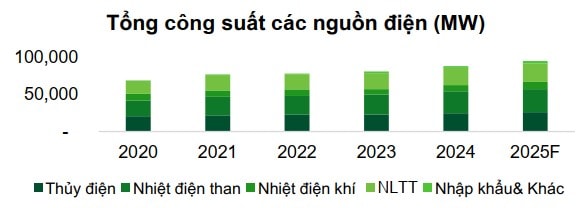PROSPECTS OF THE POWER SECTOR: RENEWABLE ENERGY TAKES THE LEAD ROLE
According to VCBS Research, under the revised Power Development Plan VIII, the Net Zero 2050 target remains the core objective, reflected through the expansion of solar and wind power capacity.

Assessing the prospects of the power sector, VCBS Research noted that in terms of electricity output in 2025, according to the electricity market operation plan, total electricity output is estimated to grow by about 11.3% compared to the previous year. However, total system output in the first five months of 2025 only increased by 3% year-on-year. Therefore, it is highly likely that the full-year growth in electricity output in 2025 will be below double digits.
According to forecasts from the National Center for Hydro-Meteorological Forecasting, between May and November 2025, there is a 55–90% probability that neutral conditions will persist. With the seasonal characteristics of hydropower in the second half of the year, this group’s output is expected to remain high.
VCBS Research estimates that in 2025, the system’s peak load (Pmax) may reach 54.3GW, with the North potentially reaching 28.2GW. The available capacity in the North is around 29GW. Therefore, electricity supply in the northern region will likely face severe pressure in June–July and gradually ease toward the end of the year.
Regarding additional capacity in the 2025–2027 period, VCBS Research stated that for solar power, the additional capacity from 2025–2030 is estimated at about 54GW, of which around 28GW will be concentrated in the North. Power sources in the North face risks of not meeting peak demand due to the slow growth of large-scale power projects, making solar deployment a suitable solution thanks to its short implementation time.
After 2030, solar power in the South is expected to develop strongly, reaching around 25GW thanks to higher radiation levels and longer sunshine hours.
For wind power, onshore and nearshore capacity is projected to grow by about 16GW, distributed relatively evenly from North to South.
For hydropower, the additional capacity in 2025–2030 is estimated at around 2.1GW. Since most of the large hydropower potential has already been exploited, remaining projects are only medium- and small-scale.
For pumped-storage hydropower (PSH) projects, the total additional capacity in the coming years is estimated at around 3.6GW. Vietnam’s first PSH project, Bac Ai, is expected to commission 4 units during 2029–2030. In early February 2025, EVN commenced phase 2 of the project, with a total investment exceeding VND 21,000 billion.

Source: Revised PDP VIII, EVN, VCBS compilation and estimates.
VCBS Research emphasized that with the adjustment to increase electricity consumption growth to about 10% per year, electricity supply must be prioritized for investment. Under the revised PDP VIII, the Net Zero 2050 target remains central, particularly through the expansion of solar and wind capacity.
In addition, to address the intermittency of solar power, storage capacity has been mandated, requiring solar projects to invest in storage systems equal to 10% of their generation capacity.
Regarding preferential policies for renewable energy development, VCBS Research reported that the Government has issued Decree No. 58/2025/ND-CP detailing several provisions of the Electricity Law on renewable and new energy development. The decree specifies incentives for renewable and new energy projects as follows:
-
Sea area use fees: Exempted during the construction period, not exceeding 3 years from the groundbreaking date. A 50% reduction applies for the following 9 years.
-
Land use and lease fees: Exempted during the construction period, not exceeding 3 years. Afterward, exemptions or reductions will comply with investment and land laws.
-
Long-term minimum contracted electricity output: 70% during loan repayment but not exceeding 12 years, unless otherwise agreed between investors and buyers. For offshore wind, the minimum contracted output is 80% during repayment but not exceeding 15 years.
-
Priority dispatch: Renewable projects with storage systems connected to the national grid will be prioritized during peak hours, except for self-consumption sources.
Regarding corporate income tax, VCBS Research noted that renewable energy projects will enjoy incentives under Articles 15 and 16 of Decree No. 218/2013/ND-CP. Accordingly, projects will be exempt from tax for 4 years, receive a 50% reduction for the following 9 years, and enjoy a preferential tax rate of 10% for 15 years.
On investor selection, under Decree No. 56/2025/ND-CP issued on March 3, 2025, renewable projects such as solar, wind, hydropower, and biomass listed in the revised PDP VIII must be tendered if there are two or more investors.
“With the revised PDP VIII, we see a consistent direction toward the green transition of the power sector, aiming for Net Zero by 2050. Therefore, regardless of low or high scenarios, the capacity of renewable sources (solar, wind) will experience tremendous growth,” VCBS Research concluded.
— Source: Business Forum Magazine


